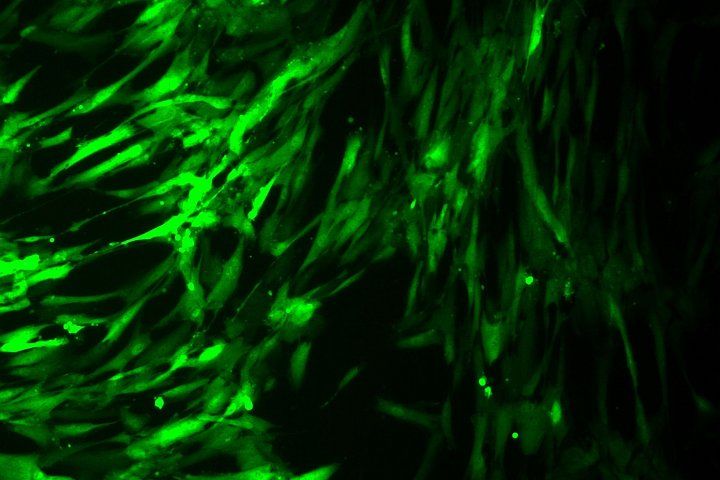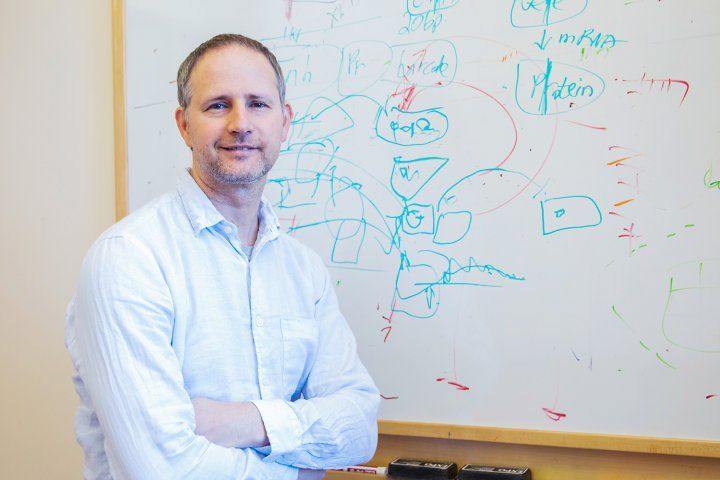
Osteoblasts infected with a virus containing archaic DNA sequences, a reporter molecule, and GFP. Image courtesy Nadav Ahituv.
Much of the genetic difference between modern humans and our archaic ancestors - Neanderthals and Denisovans - is not in our genes themselves, which make up only 2 percent of the human genome, but in regions of DNA that regulate gene expression by turning genes on and off. A team at UC San Francisco, in collaboration with colleagues at Stanford University, has unearthed the regulatory DNA sequences of our archaic human ancestors in a discovery that sheds light on how we diverged from them 500,000 years ago.
"It's like we're resurrecting fossils and making them come alive one DNA sequence at a time," said Nadav Ahituv, PhD, a professor of bioengineering, and co-senior author of the new study.
Being able to see which regions of DNA are involved when genes are turned on and off allows researchers to recreate the unique molecules those regions code for, he said, and to reconstruct biochemistry that happened long ago.
The results, a collaboration between Ahituv's lab and researchers in the labs of Dmitri Petrov and Hunter Fraser at Stanford, were published April 22 in eLife and offer genetic explanations for some of the differences between modern humans and our ancient ancestors.
Resurrecting Ancient Gene Expression
Ahituv, along with Lana Harshman, a doctoral student in the Tetrad graduate program and co-lead author of the paper, looked for DNA sequence changes that are present in humans but not in Neanderthals or Denisovans, both of which are considered members of the genus Homo to which modern humans also belong.
The team identified 14,042 regions of archaic DNA in which the sequence of nucleotides (the four DNA "letters" - A, G, C, and T - that make up DNA) differs from those in modern humans. To test whether these nucleotide changes affect gene regulation, Harshman employed a process called a massively parallel reporter assay.
The massively parallel reporter assay involves packaging each of the variants into a virus, along with a "reporter" that produces a barcoded molecule identifying the variant DNA sequence it came from. They also added a protein that glows green under UV light, allowing them to confirm that the DNA package was delivered inside the cell. If that variant affects gene expression, the reporter produces a barcoded molecule that identifies what DNA sequence it came from. The barcode allows the researchers to scan the products of thousands of variants at once.
Harshman then infected three types of cells related to the brain, skeleton and early development with these viral packages. She chose these particular cell types because they are most likely to reveal evolutionary differences between us and our Neanderthal ancestors. Results of the assay were analyzed by Carly Weiss, PhD, a postdoctoral researcher at Stanford and co-lead author on the paper, and David Gokhman, PhD, a postdoctoral researcher at Stanford and co-corresponding author on the paper.
In total, the researchers found that of the 14,042 variants they had identified, 407 represented a change in expression in modern humans compared to our predecessors. Among that list, genes affecting the cerebellum and voice box, pharynx, larynx, and vocal cords seem to be overrepresented, a fact notable because these genes may tell us something about the structure of our ancient ancestors' soft tissues, which have long since disintegrated.
These genetic sequences provide scientists with a deeper view into how modern humans diverged from Neanderthals and Denisovans, and which characteristics were favored by evolution.
A Library of Ancient DNA to Test in Modern Human Cells
In the process of analyzing these variants, Ahituv and Harshman created a catalog of archaic DNA sequences that they and other researchers can investigate one by one. Their next step is to explore what happens when individual variants are put into human cells, said Ahituv.

Nadav Ahituv, PhD.
"We'll now be able to take one Neanderthal variant that's particularly interesting in terms of which genes it turns on and off and put it in a modern human cell to see how it changes the cell's characteristics," said Ahituv.
For Harshman, those experiments represent more than simply comparing the impact of gene sequences.
"Skeletal remains and Neanderthal DNA have only given us the most basic understanding of how we differ from our ancestors," she said. "Our work here opens up a whole new avenue of things to explore when it comes to the big question of what makes us human."






